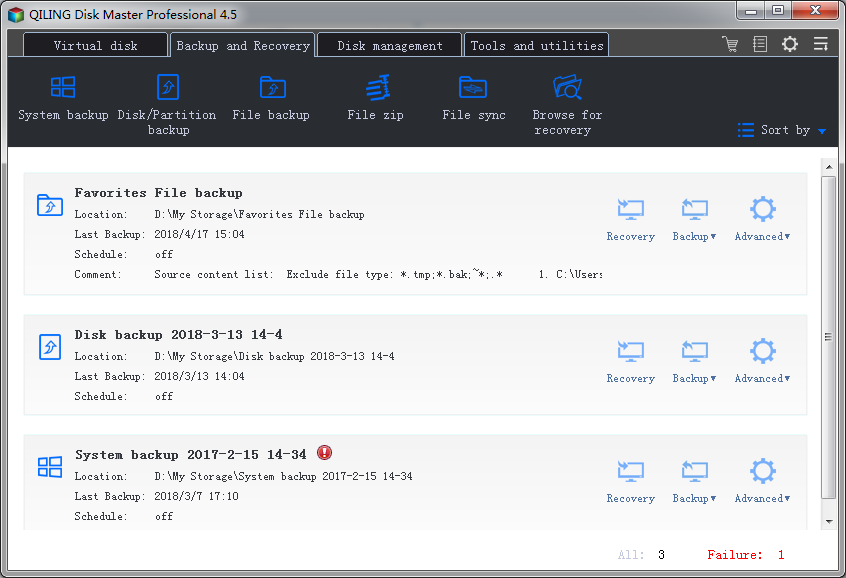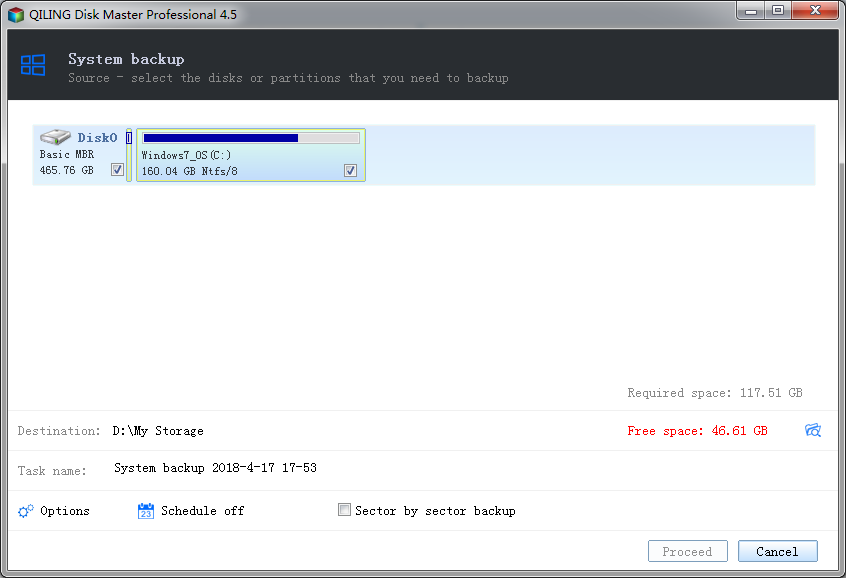2 Way for How to Create Windows 10 System Image on USB Flash Drive
Quick Navigation:
- Part 1. Why you need to create a Windows 10's System Image on USB Flash Drive
- Part 2. How to Create Windows 10's System Image on a USB drive
- Method #1. How to Create Windows 10's System Image on USB Intelligently
- Step 1. Plug your USB Flash Drive
- Step 2. Open QILING Disk Master software
- Step 3. Select the backup path
- Step 4. Create the Windows 10 System Image
- Method #2. Create a Windows 10's System Image on USB Drive with Windows Built-in Feature
- Either
- Open settings.
- Part 3. How to Fix "this drive is not a valid backup location" Error
- *Use a different USB Flash Device:
- *Use backup software:
- *Check for a USB Drive Error:
- To update your USB's driver:
Creating a Windows 10 system image on USB flash drive is a must if you want to keep your computer safe. This article covers two ways for how to create a Windows 10 system image on USB drive. One is making use of Windows 10 built-in feature and another one is using the intelligent backup software.
Windows 10 system image is an exact copy, in other words, a complete backup of a Windows 10's drive or a partition in its drive. This is a way of saving your data into a different hard drive or a USB Flash Drive, which will be covered below. A Windows 10's system image contains absolutely everything on your hard drive as well as the operating system (if present in the chosen drive).
Part 1. Why you need to create a Windows 10's System Image on USB Flash Drive
When you create a Windows 10 system image on a USB Flash drive, you have a lot of benefits, for example;
- It is a safe method of backing up.
- It is a portable way of creating and saving a Windows 10's system image.
- It is easy to restore on any other computer.
- You can save storage space for more input as you free up usable storage space in your drive.
- Any time your system crashes, you are able to restore everything to the last kilobyte.
Hence creating a Windows 10's System image on your USB is useful as you gain control over your information and can retrieve it anywhere and at any moment in time of need.
Part 2. How to Create Windows 10's System Image on a USB drive
There are two ways of creating a windows 10's System image on a USB drive. These two methods will be covered below.
Method #1. How to Create Windows 10's System Image on USB Intelligently
Here to create a Windows 10's system image on USB Drive, we will proceed with the use of powerful and professional software known as QILING Disk Master. This is a tool you can use that can help you securely store your data to your USB Flash Drive saving you from any loss of data probably due to accidental deletions or crashing of data. As mentioned above, sing the best Windows image backup software is secure and easy to use, so it is recommended to use it whenever you want to create a Windows 10's system image. To create a system image using QILING Disk Master, you should follow the steps below.
Step 1. Plug your USB Flash Drive
Connect a USB Drive that is exactly equal to or bigger than your total data size. If the USB drive size is smaller, a system image can't be created in it.
Step 2. Open QILING Disk Master software
Open the tool by clicking on the QILING Disk Master icon twice or right-clicking and selecting the "Open" option. As it opens, click on "System Backup".

Step 3. Select the backup path
Choose the USB Flash Drive into which you want to create the Windows 10's system image.
Step 4. Create the Windows 10 System Image
Give the backup file a name, choose between automatic backup or sector by sector backup, and click "Proceed" to create a Windows 10 image on USB. Given that it is the creation of a system image, it will take some time.

Method #2. Create a Windows 10's System Image on USB Drive with Windows Built-in Feature
If you don't have the appropriate software or you prefer doing it directly from your computer, you can create a system image from your computer directly with Window 10's built-in feature "Backup and Restore (Windows 7)". It is a cheaper method of doing it like no other software is needed for the process. But compared to method 1 above, it is longer and may take more time or produce the "This drive is not a valid backup location" Error (this error and its solutions are covered below).
To use Window's built-in feature, we go through the series of steps below:
We can access the feature in two different ways.
Either
1. Access the control panel by either. Right-clicking on the start button and clicking on the control panel or type control panel in search and open it.
2. As the control panel opens, click on "Backup and Restore" feature. Or open settings > select updated and security > select backup > select "Backup and Restore" feature.
Open settings.
3. Once you reach this feature, the rest of the procedure stays the same as follows: select "Create a system image". Once you click on this, Windows 10 will scan your computer and open a window on which you will be asked to choose your backup device. Then you choose your USB Drive.
4. Select Start Backup. Once you do this, an image will be created and a progress screen will be displayed.
This will take some time and will be completed. Once it gets completed, windows will give you the option to create a USB recovery drive which is helpful if you haven't made one yet.
Part 3. How to Fix "this drive is not a valid backup location" Error
Sometimes, you may have the error "This drive is not a valid backup location" as a result of a problem with the USB drive or a system error. Here, we will show you how to repair this.
*Use a different USB Flash Device:
Your USB Flash may be the reason you can't create a Windows 10 System Image. It may either be damaged or may not have enough space (remember 64GB is not exactly 64GB, so don't use a USB Flash with equal space to that of the system image).
*Use backup software:
Sometimes it is necessary to use backup software such as QILING Disk Master. In case you encounter this error, give the first method above a try as the use of software eases the procedure, and prevents error.
*Check for a USB Drive Error:
- 1. Plug the USB Flash Drive into your pc, access File Explorer and right-click on your USB Drive then select "Properties".
- 2. Select "Tools tab" and click on the "Check" button.
As the scan gets completed, close the window then eject your USB drive and plug it in again. Try creating the Windows 10's system image in the USB Flash Drive again and if it still fails, try the next method. Update USB Flash Drive Driver:
To update your USB's driver:
- 1. Plug your USB Flash drive. Open Device Manager. This can be done by right-clicking on the Start button at the bottom left of the screen and clicking the device manager.
- 2. Click on the drop-down arrow on "Disk drives" and right-click on the USB Flash Drive into which the system image is to be made, then select "update driver".
- 3. Choose "automatically search for driver software online".
Making and having a Windows 10's system image is important because we never know when our system will crash or information will be lost. But in the process of making one, it is advised to use QILING Disk Master tool as it is necessary to make the system image the right way while avoiding system damage in any form.
Related Articles
- Top 5 Windows Image Backup Software for 2020
- How to Create Windows 10 System Image Backup
- How to Full/Complete System Backup of Windows 10 Guide
- RAID Types: What is RAID and Which RAID Level Should Use
Are you seeking deep insights into RAID Types and RAID Levels? Guess what? You're in for a treat! Here, we have compiled a guide to help users understand this technology. - MP3 Recovery Software: How to Recover MP3 Files for Free from All Devices
Most of the music files and other audio files are in the format of MP3. Your MP3 files may get lost due to deletion or other misoperations. Luckily, you can download the MP3 recovery software - Deep Data Recovery and easily recover the deleted or lost MP3 files from an external storage medium like a USB, SD card, external hard drive, or from a device like an iPod and a music player. - Samsung Launches 'Repair Mode' to Protect Users' Data Security When Repairing Phones
Samsung has recently launched a repair mode, and this article will give you the information about Samsung Repair Mode.